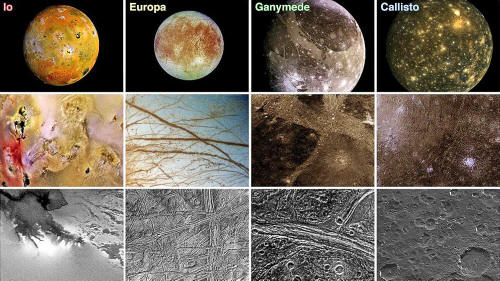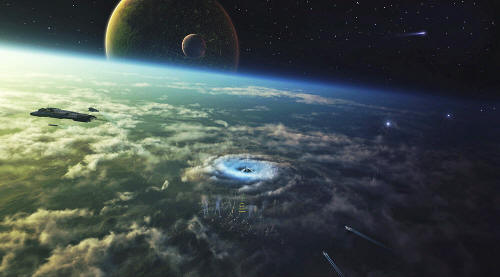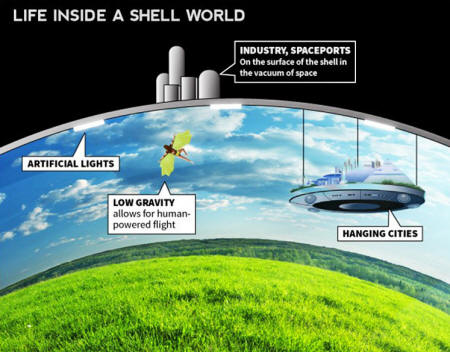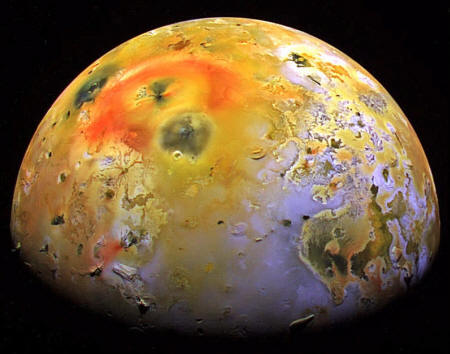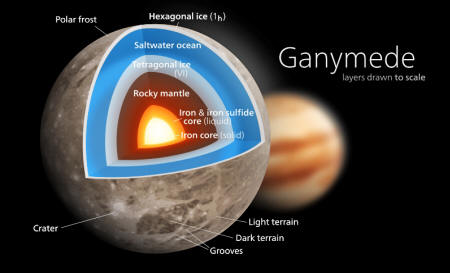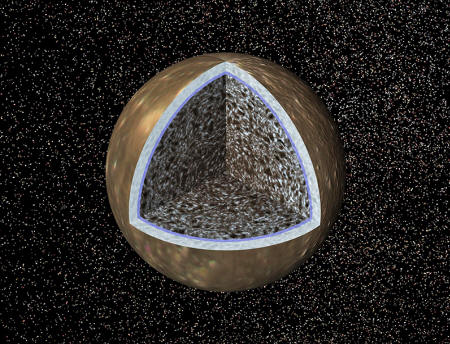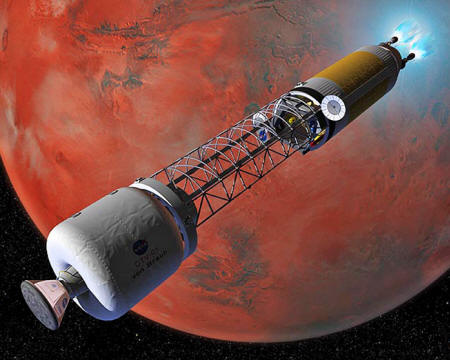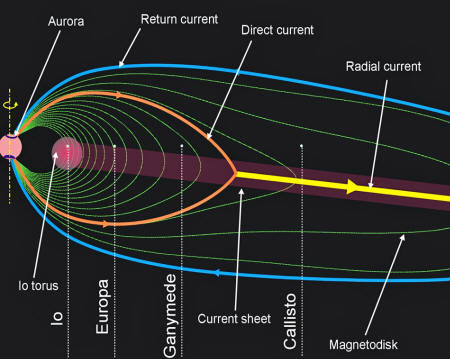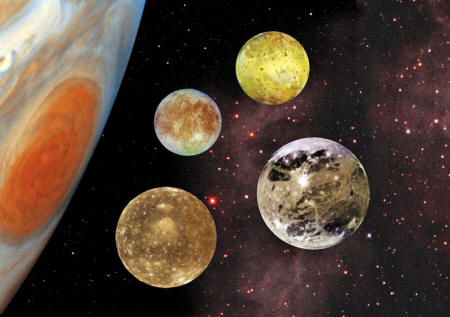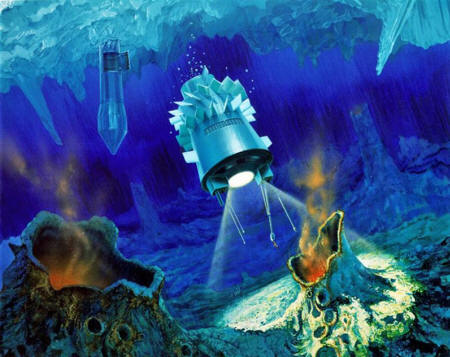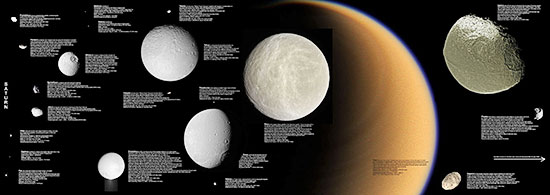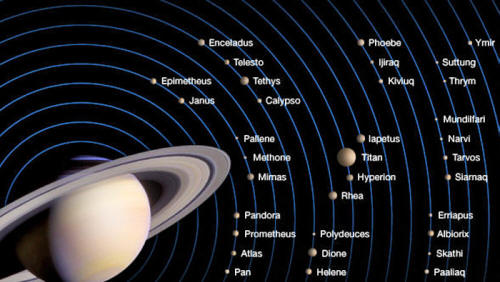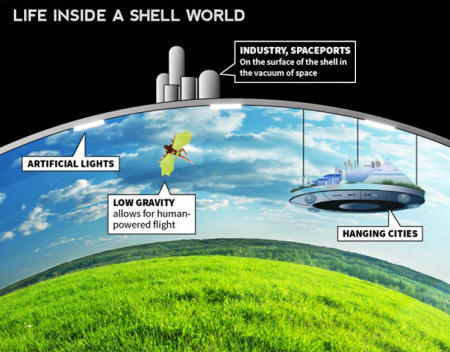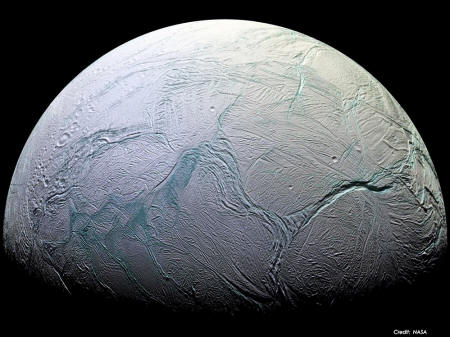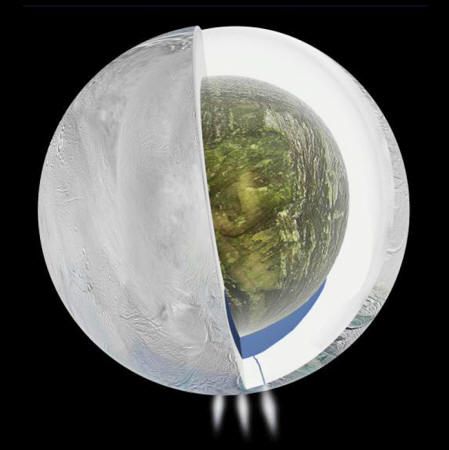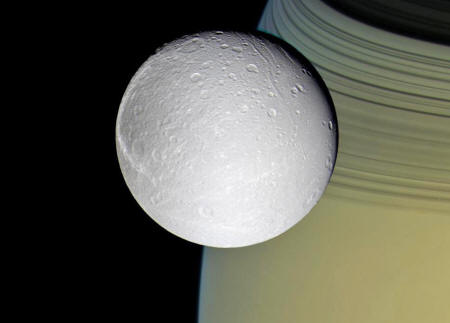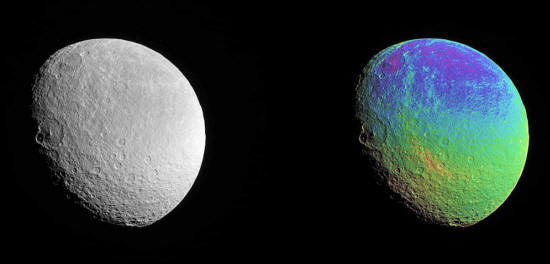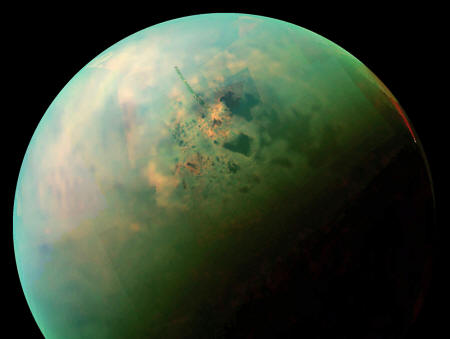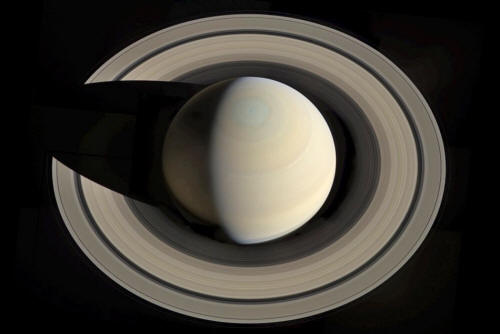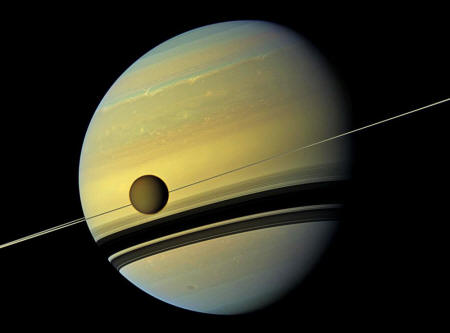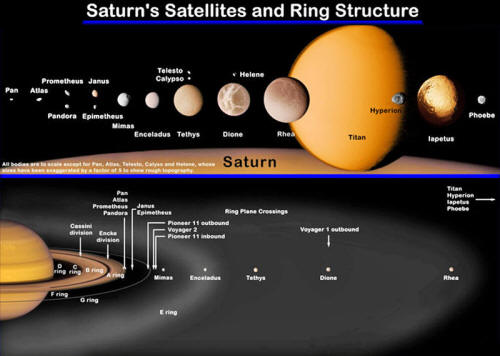|
Continuing with our "Definitive Guide to Terraforming", we present our guide to terraforming Solar System's Moons.
Much like terraforming the inner Solar System, it might be feasible someday.
But should we?
Jupiter's Moons? 22 April, 2016 from UniverseToday Website
Surface Features of the Four members
at different levels
of zoom in each row
Fans of Arthur C. Clarke may recall how in his novel, 2010 - Odyssey Two (or the movie adaptation called 2010: The Year We Make Contact), an alien species turned Jupiter into a new star.
In so doing, Jupiter's moon Europa was
permanently terraformed, as its icy surface melted, an atmosphere
formed, and all the life living in the moon's oceans began to emerge
and thrive on the surface.
In short, it is possible that humans could terraform one of more of the Jovians to make it suitable for full-scale human settlement someday.
In honor of Jupiter's namesake, they are sometimes collectively referred to as the Jovians. Of these, the four largest, ...are known as the Galileans (in honor of their founder, Galileo Galilei).
These four moons are among the largest
in the Solar System, with Ganymede being the largest of them all,
and even larger than the planet Mercury.
This resonance helps maintain these
moons' orbital eccentricities, which in turn triggers tidal flexing
their interiors.
Ultimately, these come down to the particular moon's structure and composition, its proximity to Jupiter, the availability of water, and whether or not the moon in question is dominated by Jupiter's powerful magnetic field.
Basically, its all about leveraging the indigenous resources and the moons' own interactions with Jupiter's magnetic field to create a breathable atmosphere.
The process would begin by heating the
surface in order to sublimate the ice, a process which could involve
orbital mirrors to focus sunlight onto the surface, nuclear
detonators, or crashing comets/meteors into the surface.
Credit:
deviantart.com/Wasteland-3D
These would in turn create a greenhouse
effect, warming the surface even more, and triggering a process
known as radiolysis (the dissociation of molecules through exposure
to nuclear radiation).
This process already takes place around
Europa, Ganymede and Callisto, and is responsible for their tenuous
atmospheres (which contain oxygen gas).
With nitrogen acting as a buffer gas, a
nitrogen-oxygen atmosphere with sufficient air pressure to sustain
humans could be created.
An engineer suggests building a roof over a small planet so that Earthlike conditions could be maintained. Credit: by Karl Tate, Infographics Artist See more at:
In the case of the Jovians, this would
involve building large "Shell
Worlds" to encase them, keeping the atmospheres inside
long enough to effect long-term changes.
Such a shell would ensure that the process of creating of an atmosphere could be carefully controlled and none would be lost before the process was complete.
Because of this, Io is completely enveloped by Jupiter's powerful magnetic field, which also why the surface is exposed to significant amounts of harmful radiation.
In fact, Io receives an estimated 3,600
rem (36 Sv) of ionizing radiation per day, whereas living organisms
here on Earth experience an average of 24 rem per year!
Enhanced-color image of Jupiter's moon Io, showing sulfur dioxide frost (white and grey) and other types of sulfur deposits as yellow and brown. Recent volcanic activity is marked by red and black blotches. Credit: NASA
The moon's 2:1 and 4:1 orbital resonance
with Europa and Ganymede (see below) also contributes to its orbital
eccentricity of 0.0041, which is the primary reason for Io's
geologic activity.
In fact, based on magnetic measurements
and heat-flow observations, a magma ocean is believed to exist some
50 km below the surface, which itself is about 50 km thick and makes
up 10% of the mantle. It is estimated that the temperature in the
magma ocean reaches 1473 K (1200 °C/2192 °F).
The friction or dissipation produced in Io's
interior due to this varying tidal pull creates significant tidal
heating within Io's interior, melting a significant amount of Io's
mantle and core.
Consistently, the surface of is covered in smooth plains dotted with tall mountains, pits of various shapes and sizes, and volcanic lava flows.
It's colorful appearance (a combination
of orange, yellow, green, white/grey, etc.) is also indicative of
volcanic activity which has covered the surface in sulfuric and
silicate compounds and leads to surface renewal.
The planet is far too hostile, far too
dry, and far too volcanically active to ever be turned into
something habitable!
Europa
If Io could be characterized as hellish, lava-spewing place (and it certainly can!), then Europa would be calm, icy and watery by comparison.
With a mean radius of about 1560 km and
a mass of 4.7998 ×1022 kg, Europa is also slightly
smaller than Earth's Moon, which makes it the sixth-largest moon and
fifteenth largest object in the Solar System.
At this distance from Jupiter, Europa
still experiences quite a bit of radiation, averaging about 540 rem
per day.
Given the combination of these factors, it
is considered a strong possibility that organic life also exists in
this ocean, possibly in microbial or even multi-celled form, most
likely in environments similar to Earth's deep-ocean hydrothermal
vents.
Using nuclear devices, cometary impacts, or some other means to increase the surface temperature, Europa's surface ice could be sublimated and form a massive atmosphere of water vapor.
This vapor would then undergo radiolysis due to exposure to Jupiter's magnetic field, converting it into oxygen gas (which would stay close to the planet) and hydrogen that would escape into space.
The resulting planet would be an ocean world, where floating settlements could be built that floated across the surface (due to oceans depths of ~100 km, they could not be anchored).
Because Europa is tidally-locked, these colonies could move from the day-side to the night-side in order to create the illusion of a diurnal cycle.
At this distance, it takes seven days
and three hours to completes a single revolution. Like most known
moons, Ganymede is tidally locked, with one side always facing
toward the planet.
However, with a mass of 1.4819 x 10²³ kg
(the equivalent of 0.025 Earths), it is only half as massive, which
is due to its composition, which consists of water ice and silicate
rock.
Sufficient enough to limit the effects
of muscle and bone degeneration, this lower gravity also means that
the moon has a lower escape velocity - which means it would take
considerably less fuel for rockets to take off from the surface.
of the internal structure of Ganymede.
Credit: Wikipedia
Commons/kelvinsong
All told, Ganymede receives about 8 rem
of radiation per day - a significant reduction from Europa and Io,
but still well above human tolerances.
Again, the result would be an ocean
world, but one with significantly deeper oceans (~800 km).
Combined with oxygenated water, life forms could exist at the core-mantle boundary in the form of extremophiles, much like on Europa.
With a mean radius of 2410.3 ± 1.5 km (0.378 Earths) and a mass of 1.0759 × 1023 kg (0.018 Earths), Callisto is the second largest of Jupiter's moons (after Ganymede) and the third largest satellite in the solar system.
It is similarly comparable in size to
Mercury - being 99% as large - but due to its mixed composition, it
has less than one-third of Mercury mass.
showing a surface ice layer, a possible liquid water layer, and an ice–rock interior.
Credit: NASA/JPL
Much like the others, the moon has an abundant supply of water in the form of surface ice (but also possibly liquid water beneath the surface). But unlike the others, Callisto's distance from Jupiter means that colonists would have far less to worry about in terms of radiation.
In fact, with a surface exposure of
about 0.01 rem a day, Callisto is well within human tolerances.
This is particularly likely if the
interior ocean is made up of salt-water, since halophiles (which
thrive in high salt concentrations) could live there.
In essence, while Callisto possesses the
necessary pre-biotic chemistry to host life, it lacks the necessary
energy.
The resulting world would be an ocean planet, but with oceans that reached to depths of between 130 and 350 km.
Potential
Challenges
To break it down, converting one or more of the Galileans into something habitable to humans presents many difficulties, some of which may prove to be insurmountable.
These include, but are are not limited to:
Basically, the Jovian system is pretty far from Earth.
On average, the distance between Jupiter and Earth is 628,411,977 million km (4.2 AU), roughly four times the distance between the Earth and the Sun. To put that into perspective, it took the Voyager probes between 18 months and two years to reach Jupiter from Earth.
Ships designed to haul human passengers
(with enough supplies and equipment to sustain them) would be much
larger and heavier, which would make the travel time even longer.
While this sort of technology is being
investigated for crewed missions to Mars, it is still very much in
the research and development phase.
using its nuclear-thermal rocket engines to slow down and establish orbit around Mars.
Credit: NASA
But thus far, no such drive systems
exist, with some being decades or more away from feasibility.
Just as important is the need for
refueling and supply stations between Earth and the Jovian System -
like an outpost on the Moon, a permanent base on Mars, and bases on
Ceres and in the Asteroid Belt.
Building an enveloping structure big enough for an entire moon - which range from 3121.6 km to 5262.4 km in diameter - would require massive amounts of material.
While these could be harvested from the
nearby Asteroid Belt, it would require thousands of ships and robot
workers to mine, haul, and assemble the minerals into large enough
shells.
and co-rotation enforcing currents.
Credit: Wikipedia
Commons/Ruslik0
As noted already, Earth organisms are exposed to an average of 24 rem per year, which works out to 0.0657 rem per day. An exposure of approximately 75 rems over a period of a few days is enough to cause radiation poisoning, while about 500 rems over a few days would be fatal.
Of all the Galileans, only Callisto
falls beneath this terminal limit.
These satellites are lost on a regular basis, and new ones are added all the time.
So colonists would naturally have to
worry about space rocks slamming into their ocean world, causing
massive waves and blotting out the sky with thick clouds of water
vapor.
In order to maintain the effects of
terraforming, colonists would need to replenish the atmosphere over
time.
and the Galilean satellites.
Credit: NASA
While estimates vary, transforming Europa, Ganymede and Callisto would result in oceans that varied in depth - from 100 km (in the case of Europa) to extreme depths of up to 800 km (in the case of Ganymede).
In contrast, the greatest depth ever
measured here on Earth was only about 10 km (6 miles) deep, in the
Pacific's Mariana Trench.
But it is a safe bet that they would
result in tremendously high tides (at best) to water being lost to
space.
If, as scientists currently suspect,
there is in fact indigenous life on one or more of the Jovian moons,
then the effects of terraforming could have severe consequences or
them. For instance, if bacterial life forms exist on the underside
of Europa's icy surface, then melting it would mean death for these
organisms, since it would remove their only source of protection
from radiation.
And the presence of organisms introduced
by humans (i.e. germs), could have a similarly devastating effect.
(a robot capable of penetrating water ice) in Europa.
Credit: NASA
Such an act would be tantamount to genocide (or xenocide, as the case may be), and exposure to alien organisms would surely pose health risks for human colonists as well.
For starters, it doesn't seem likely or practical for us to contemplate doing this until we've established a presence on,
Second, terraforming any of Jupiter's moons would involve a considerable amount of time, energy and resources.
And given that a lot of these moon's
resources could be harvested for terraforming other worlds (such as
Mars and Venus), would it not make sense to terraform these worlds
first and circle back to the outer Solar System later?
And last, but not least, any act of terraforming these moons would invariably threaten any life that already exists there.
And the threat caused by exposure
wouldn't exactly be one-way. Under all of these circumstances, would
it not be better to simply establish outposts on the surface, or
perhaps within or directly underneath the ice?
And in time, we might even begin thinking about renovating the places so more of our kin can drop by.
Before we do any of that, we had better
make sure we know what we're doing, and be sure we aren't doing any
harm in the process!
Saturn's Moons? from UniverseToday Website
Within this system, there is also enough resources that if humanity were to harness them - i.e. if the issues of transport and infrastructure could be addressed - we would be living in an age a post-scarcity.
But on top of that, many of these moons
might even be suited to terraforming, where they would be
transformed to accommodate human settlers.
And between all of that, terraforming
Saturn's moons would require a massive commitment in time, energy
and resources, not to mention reliance on some advanced technologies
(some of which haven't been invented yet).
Of these, the largest moons are divided into two groups: the inner large moons (those that orbit close to Saturn within its tenuous E-Ring) and the outer large moons (those beyond the E-Ring).
They are, in order of distance from Saturn,
Credit: NASA/JPL
Among them, Titan is appropriately
named, being the largest and most massive of all the inner or outer
moons (to the point that it is larger and more massive than all the
others combined).
And in the end, it is the presence of
these moons around Saturn that makes the system an attractive option
for exploration and colonization.
Of these systems, Saturn would be the most important, thanks to its relative proximity to Earth, low radiation, and excellent system of moons.
Possible
Methods
In all cases, this would involve heating
the surfaces through various means - like thermonuclear devices,
impacting the surface with asteroids or comets, or focusing sunlight
with orbital mirrors - to the point that surface ice would
sublimate, releasing water vapor and volatiles (such as ammonia and
methane) to form an atmosphere.
This could be done by using the same orbital mirrors to focus sunlight onto the surfaces, triggering the creation of oxygen and hydrogen gas from water ice through photolysis.
While the oxygen would remain closer to
the surface, the hydrogen would escape into space.
In the case of the Cronian moons, this
would involve building large "Shell
Worlds" to encase them, keeping the newly-created
atmospheres inside long enough to effect long-term changes.
so that Earthlike conditions could be maintained.
Credit: Karl Tate/Infographics
Artist
Such a shell would ensure that the process of creating of an atmosphere could be carefully controlled and none would be lost before the process was complete.
It is ovoid in shape and orbits Saturn
at a distance of 185,539 km with an orbital period of 0.9 days. The
low density of Mimas, which is estimated to be 1.15 g/cm³ (just
slightly higher than that of water), indicates that it is composed
mostly of water ice with only a small amount of rock.
Any atmosphere that could be created by melting its ice would likely be lost to space. In addition, its low density would mean that the vast majority of the planet would be ocean, with only a small core of rock.
This, in turn, makes any plans to settle on the surface impractical.
It orbits Saturn at a distance of 237,948 km and takes 1.4 days to complete a single orbit. Though it is one of the smaller spherical moons, it is the only Cronian moon that is geologically active - and one of the smallest known bodies in the Solar System where this is the case.
This results in features like the famous
"tiger stripes" - a series of continuous, ridged, slightly curved
and roughly parallel faults within the moon's southern polar
latitudes.
as pictured by the Cassini space probe.
Credit: NASA/JPL/ESA
These jets are one of several
indications that Enceladus has liquid water beneath it's icy crust,
where geothermal processes release enough heat to maintain a warm
water ocean closer to its core.
The composition of the plumes
also indicate that the subsurface ocean is salty, and contains
organic molecules and volatiles. These include ammonia and simple
hydrocarbons like methane, propane, acetylene, and formaldehyde.
Combined with photolysis, radiolysis, and bacteria, the water vapor and ammonia could also be converted to a nitrogen-oxygen atmosphere. The higher density of Enceladus (~1.61 g/cm3) indicates that it has a larger than average silicate and iron core (for a Cronian moon).
This could provide materials for any
operations on the surface, and also means that if the surface ice
were to be sublimated, Enceladus would not consist mainly of
incredibly deep oceans.
This energy source, combined with organic molecules, nutrients, and the prebiotic conditions for life, means that is possible that Enceladus is home to extraterrestrial life.
NASA's Cassini spacecraft and Deep Space Network suggest that Saturn's moon Enceladus, which has jets of water vapor and ice gushing from its south pole, also harbors a large interior ocean beneath an ice shell,
as this illustration
depicts. and the jets of water vapor that periodically erupt from its southern polar region.
Credit:
NASA/JPL-Caltech
As a result, terraforming Enceladus could result in the destruction of the natural life cycle on the moon, or release life forms that could prove harmful to any future colonists.
The majority of its surface is made up
of heavily cratered and hilly terrain and a smaller and smoother
plains region. Its most prominent features are the large
impact
crater of Odysseus, which measures 400 km in diameter, and a vast
canyon system named
Ithaca Chasma - which is concentric with
Odysseus and measures 100 km wide, 3 to 5 km deep and 2,000 km long.
It is not currently known whether Tethys is differentiated into a rocky core and ice mantle. However, given the fact that rock accounts for less 6% of its mass, a differentiated Tethys would have a core that did not exceed 145 km in radius.
On the other hand, Tethys' shape - which
resembles that of a triaxial ellipsoid - is consistent with it
having a homogeneous interior (i.e. a mix of ice and rock).
Because of this, Tethys is also off the terraforming list. If in fact it has a tiny rocky interior, treating the surface to heating would mean that the vast majority of the moon would melt and be lost to space.
Alternately, if the interior is a homogeneous mix of rock and ice, then all that would remain after melting occurred would be a cloud of debris.
The majority of Dione's surface is
heavily cratered old terrain, with craters that measure up to 250 km
in diameter. With an orbital distance of 377,396 km from Saturn, the
moon takes 2.7 days to complete a single rotation.
While the source of this atmosphere is
currently unknown, it is believed that it is the product of
radiolysis, where charged particles from Saturn's radiation belt
interact with water ice on the surface to create hydrogen and oxygen
(similar to what happens on Europa).
However, it is not currently known if Dione possesses the right combination of volatilizes to ensure that nitrogen gas can be created, or that a greenhouse effect will be triggered.
Combined with Dione's low density, this
makes it an unattractive target for terraforming.
with Saturn's rings visible in the background. Credit: NASA/JPL
With an orbital radius of 527,108 km, it
is the fifth-most distant of the larger moons, and takes 4.5 days to
complete an orbit. Like other Cronian satellites, Rhea has a rather
heavily cratered surface, and a few large fractures on its trailing
hemisphere.
This low density means that although
Rhea is the ninth-largest moon in the Solar System, it is also the
tenth-most massive.
This liquid-water ocean, should it exist, would likely be located at the core-mantle boundary, and would be sustained by the heating caused from the decay of radioactive elements in its core.
Interior ocean or not, the fact that the
vast majority of the moon is composed of ice water makes it an
unattractive option for terraforming.
Credit: NASA/JPL/Space Science Institute
In fact, at 5,150 km in diameter, and 1,350×1020 kg in mass, Titan is Saturn's largest moon and comprises more than 96% of the mass in orbit around the planet.
Based on its bulk density of 1.88 g/cm3,
Titan's composition is half water ice and half rocky material - most
likely differentiated into several layers with a 3,400 km rocky
center surrounded by several layers of icy material.
Another thing Titan has in common with
Earth, unlike every other moon and planet in the Solar System, is
atmospheric pressure. On the surface of Titan, the air pressure is
estimated to be around 1.469 bars (1.45 times that of Earth).
Titan is also the only body in the Solar
System beside Earth with bodies of liquid on its surface, in the
form of methane-ethane lakes in Titan's north and south polar
regions.
The presence of this ocean, plus the
prebiotic environment on Titan, has led some to suggest that life
may exist there as well.
remains a focal point of scientific research.
Credit: NASA
As has been suggested, life could exist
in Titan's lakes of liquid methane just as organisms on Earth live
in water. Such organisms would inhale dihydrogen (H²) in place of
oxygen gas (O²), metabolize it with acetylene instead of glucose,
and then exhale methane instead of carbon dioxide.
However, the existence of these conditions remains a subject of fascination among scientists.
And since its atmosphere is thought to
be analogous to Earth's in the distant past, proponents of
terraforming emphasize that Titan's atmosphere could be converted in
much the same way.
Additionally, Titan has an atmospheric
pressure one and a half times that of Earth, which means that the
interior air pressure of landing craft and habitats could be set
equal or close to the exterior pressure.
The thick atmosphere also makes radiation a
non-issue, unlike with other planets or Jupiter's moons.
And while Titan's atmosphere does contain flammable compounds, these only present a danger if they are mixed with sufficient enough oxygen - otherwise, combustion cannot be achieved or sustained.
Finally, the very high ratio of atmospheric density to surface
gravity also greatly reduces the wingspan needed for aircraft to
maintain lift.
For starters, orbital mirrors could be
used to direct more sunlight onto the surface. Combined with the
moon's already dense and greenhouse gas-rich atmosphere, this would
lead to a considerable greenhouse effect that would melt the ice and
release water vapor into the air.
However, the orbital mirrors would need to remain in place in order to ensure the environment did not become extremely cold again and revert to an icy state.
And at a distance of 3,560,820 km from
Saturn, it is the most distant of the large moons, and takes 79 days
to complete a single orbit. Due to its unusual color and composition
- its leading hemisphere is dark and black whereas its trailing
hemisphere is much brighter - it is often called the "yin and yang"
of Saturn's moons.
Like many of Saturn's moons -
particularly Tethys, Mimas and Rhea - Iapetus has a low density
(1.088 ± 0.013 g/cm³) which indicates that it is composed primary of
water ice and only about 20% rock.
Though rounded in appearance, its bulging appearance disqualifies it from being classified as spherical. Because of this, Iapetus is not a likely contender for terraforming.
If in fact its surface were melted, it too would be an ocean world with unrealistically deep seas, and this water would likely be lost to space.
However, in both cases, the process of turning them into habitable worlds where human beings could exist without the need for pressurized structures or protective suits would be a long and costly one.
And much like terraforming the Jovian moons, the challenges can be broken down categorically:
In short, while Saturn may be abundant in resources and closer to Earth than either Uranus or Neptune, its really very far.
On average, Saturn is approximately 1,429,240,400,000 kms away from Earth (or ~8.5 AU the equivalent of eight and a half times the average distance between the Earth and the Sun). To put that in perspective, it took the Voyager 1 probe roughly thirty-eight months to reach the Saturn system from Earth.
For crewed spacecraft, carrying
colonists and all the equipment needed to terraform the surface, it
would take considerably longer to get there.
was created from images obtained by NASA's Cassini spacecraft on Oct. 10, 2013.
Credit:
NASA/JPL-Caltech/Space Science Institute/G. Ugarkovic
While this sort of technology is being investigated for crewed missions to Mars, it is still very much in the research and development phase.
What's more,
a large fleet of robotic spaceships and support craft would also be
needed to build the orbital mirrors, capture asteroids or debris to
use as impactors, and provide logistical support to crewed
spaceships.
All of this, in turn, raises the crucial
issue of infrastructure. Basically, any fleet operating between
Earth and Saturn would require a network of bases between here and
there to keep them supplied and fueled.
In addition, building orbital mirrors
would require considerable amounts of minerals and other resources,
many of which could be harvested from the Asteroid Belt or from
Jupiter's Trojans.
And paraterraforming using Shell Worlds
would be no different, requiring multiple trips to and from the
Asteroid Belt, hundreds (if not thousands) of construction and
support craft, and all the necessary bases in between.
appear together in this view from the Cassini spacecraft.
Credit:
NASA/JPL-Caltech/SSI
As a result, any settlements built on
the surface would likely need additional protection in orbit, like a
string of defensive satellites that could redirect comets and
asteroids before they reached orbit.
In fact, if all of Titan's ice were
melted, including the layer that is believed to sit beneath its
interior ocean, its sea level would be up to 1700 km in depth!
Enceladus would not fair any better, as
gravity measurements by Cassini have shown that the density of the
core is low, indicating that the core contains water in addition to
silicates. So in addition to a deep ocean on its surface, its core
might also be unstable.
Barring that, melting the surface ice
could cause any indigenous life forms to proliferate and mutate, and
exposure to them could prove to be a health hazard for human
settlers.
and their positions relative to Saturn's ring structures. Credit: ESA
Quite literally, there is enough water
ice, volatiles, hydrocarbons, organic molecules, and minerals in the
Saturn system to keep humanity supplied indefinitely.
As has been argued many times over, the
abundance of methane, ammonia, and water ices in the Cronian system
would be very useful in helping to turn "Earths twins" into
"Earth-like" planets.
|


